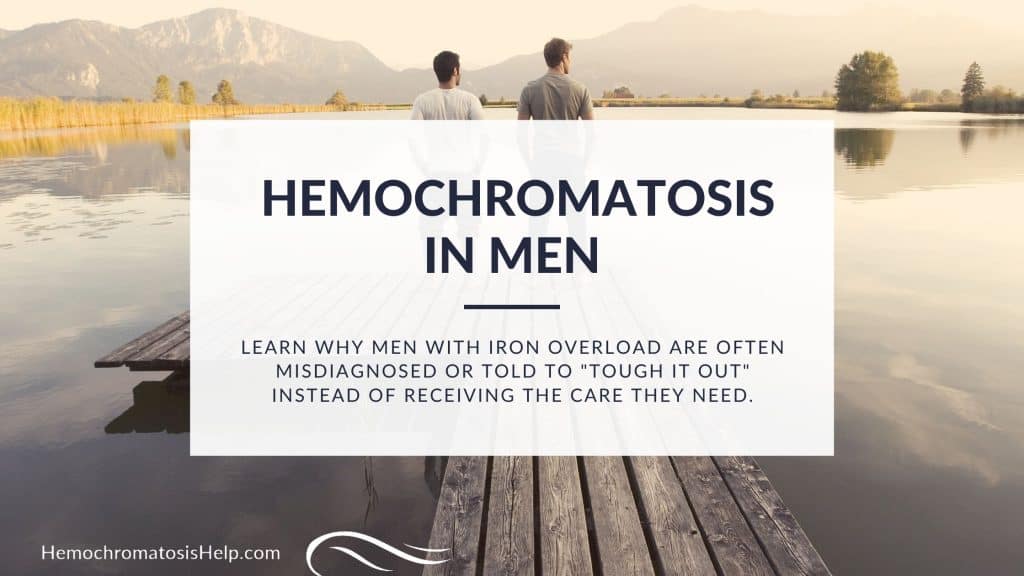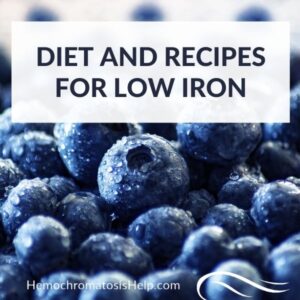In This Article
Hemochromatosis in Men
One of the primary causes of high iron levels in men is the genetic condition of hemochromatosis.
Also known as iron overload, this hereditary disorder causes the absorption of too much iron during digestion. Over time, iron levels can build up in the body and result in the development of symptoms and health complications.
Hemochromatosis Symptoms in Men
When it comes to hemochromatosis, there is a stereotype that too much iron in the blood is a symptom primarily seen in men. And while this presumption ignores how many women are affected by iron overload, there are several symptoms of iron overload unique to men.
The most common symptoms men experience when they have high iron are:
- Fatigue
- Joint Pains
- Weakness
- Weight Loss
- Stomach Pains
Middle age is the most common time of diagnosis for men with hereditary hemochromatosis or iron overload.
The problem is that often those non-specific hemochromatosis symptoms in men are blamed on something else.
Because hemochromatosis is often not diagnosed until middle age, men are sometimes just told, “You’re just getting older” and perhaps given a painkiller or an anti-depressant or even testosterone replacement therapy and sent on their way.
Even worse (and guys, you know we do this), men with high iron might not ever seek medical care. We often try to “tough it out” and ignore those aches and pains and tiredness that we didn’t have when we were younger.
So many times, a man with hemochromatosis either doesn’t get the proper diagnosis from his doctor or doesn’t seek medical attention in the first place. All the while, he is starting to experience the symptoms of too much iron in the blood.
Side Effects of Too Much Iron in Men
Over the years, hemochromatosis progresses. The iron overload works its way into the organs—the liver, the heart, the pancreas—and then men present to their doctor with liver disease, heart disease, or diabetes.
The iron has done its damage. Sometimes the damage is irreparable if found too late.
Worst of all, the doctor may then say, “You’re getting older, you now have diabetes/liver disease/heart disease” and never think to dig further to find an underlying cause to all these conditions—iron overload caused by hemochromatosis.
What are Normal Iron Levels for Men?
Without hemochromatosis, normal iron levels for men total roughly four to five grams in the body. However, in iron overload, a man may not have any symptoms until he has stored twenty grams– a significant difference!
Awareness and early diagnosis are essential to help men find out if they are, in fact, at risk of having too much iron in their bodies.
Doctors will often check a patient’s ferritin level to determine their overall iron burden. In men, normal ferritin levels range from 20 to 300 ng/mL. As iron builds up in a man’s body over time, his ferritin level also rises. The higher the ferritin level gets, the more doctors become concerned about the long-term consequences of iron overload developing. For instance, if ferritin exceeds 1,000 ng/mL, the risk of liver damage increases significantly.
Men vs. Women with Hemochromatosis
A 1997 study comparing men and women with hemochromatosis found that men are more likely to develop diabetes or liver disease due to undiagnosed hemochromatosis.
In this study, by the time iron overload was discovered, 25% of the men had already developed cirrhosis (permanent damage to their livers), and 16% had diabetes.
Hemochromatosis and Bone Loss in Men
Most people, doctors included, forget that men can get osteoporosis or loss of bone mineral density. It’s usually thought of as a women’s condition.
However, not only can men get osteoporosis, but men with genetic hemochromatosis are significantly at risk of developing bone loss.
A 2005 study looked at 38 men with hereditary hemochromatosis, with an average age of 47. All of these men had two copies of the HFE gene. Other markers that impact bone loss, such as vitamin D and parathyroid hormone levels, were normal.
The study found that 78.9% of these men had already developed osteopenia (or “pre-osteoporosis”) and 34.2% had full-blown osteoporosis!
That’s a high percentage of men with bone loss. If you’re a man with iron overload, be sure to ask your doctor to test your bone mineral density.
And yes, they may think you’re a bit strange, as often men are not routinely tested, but if it helps, you may refer them to this study to back up your request.
Iron Overload and Sexual Dysfunction in Men
A common symptom seen in men with iron overload is a loss of libido, shrinkage of testicles, erectile dysfunction, and impotence.
While not as dangerous as cirrhosis or heart disease, these are very distressing symptoms for men and something that really impacts the quality of life.
Some sources say that up to 45% of men with symptomatic hemochromatosis have impotence.
Why does too much iron affect the sex drive and sexual function in men? The most common reason is that the pituitary gland (a vital regulator of hormones found in the middle of your skull) suffers the same fate as other organs—it becomes overloaded with iron.
The excess iron of hemochromatosis causes the male sex hormones not to operate correctly—leading to hypogonadism, reduction of testosterone, and all those problems that men would rather not have.
The Importance of Treatment and Awareness in Hemochromatosis
The symptoms and consequences of hemochromatosis experienced by men and women have a much better prognosis when caught early and treated correctly. As a result, men should be sure to learn about treatment options for iron overload.
Men should also speak up and ask for the health care they need and not put off asking for help. Being proactive and speaking with your doctor when you have symptoms is one of the best ways to stay safe and healthy and prevent the more dire consequences of untreated iron overload.
- NIH Health Topics: Hemochromatosis https://www.nhlbi.nih.gov/health-topics/hemochromatosis
- Romain Moirand, Paul C. Adams, Valerie Bicheler, Pierre Brissot, and Yves Deugnier. “Clinical Features of Genetic Hemochromatosis in Women Compared with Men.” Annals of Internal Medicine 1997 127:2, 105-110.
- Jian J, Pelle E, Huang X. Iron and menopause: does increased iron affect the health of postmenopausal women?. Antioxid Redox Signal. 2009;11(12):2939-2943. doi:10.1089/ars.2009.2576
- Guggenbuhl P, Deugnier Y, Boisdet JF, Rolland Y, Perdriger A, Pawlotsky Y, Chalès G. Bone mineral density in men with genetic hemochromatosis and HFE gene mutation. Osteoporos Int. 2005 Dec;16(12):1809-14. doi: 10.1007/s00198-005-1934-0. Epub 2005 Jun 1. PMID: 15928800.
- Valenti L, Varenna M, Fracanzani AL, Rossi V, Fargion S, Sinigaglia L. Association between iron overload and osteoporosis in patients with hereditary hemochromatosis. Osteoporos Int. 2009 Apr;20(4):549-55. doi: 10.1007/s00198-008-0701-4. Epub 2008 Jul 26. PMID: 18661088.
- Andrea Duchini, MD, “Hemochromatosis Clinical Presentation.” Medscape.com. Updated: Apr 03, 2017.
- Bruce R Bacon, Janet L Kwiatkowski. “Patient education: Hereditary hemochromatosis (Beyond the Basics).” UpToDate.com.

Would you like to read hemochromatosis success stories? Learn more here.

Would you like to learn more ways to help your hemochromatosis? Join our newsletter.




